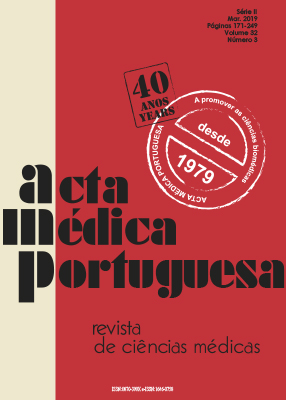Referenciação Tardia da Ambliopia Anisometrópica: Estudo Retrospetivo dos Diferentes Subtipos de Ambliopia
DOI:
https://doi.org/10.20344/amp.10623Palavras-chave:
Ambliopia/epidemiologia, Anisometropia/epidemiologiaResumo
Introdução: A ambliopia requer uma abordagem atempada para uma máxima recuperação visual. Não existe informação sobre a idade de referenciação da ambliopia. O presente artigo pretende perceber se há diferenças na idade média de referenciação para consulta terciária de Oftalmologia, entre não-amblíopes e amblíopes, num contexto sem rastreio implementado.
Material e Métodos: A amostra correspondeu a todas as crianças nascidas no Hospital de Braga entre 1997 - 2012 (3 - 18 anos de idade), com consulta de Oftalmologia em 2014. A informação foi recolhida pelos registos clínicos, tendo sido criado o grupo nãoamblíope e amblíope, dividido em estrábico e refrativo (anisometrópico/bilateral).
Resultados: A amostra contemplou 1665 participantes, 1369 (82,2%) não-amblíopes e 296 (17,8%) amblíopes. Dentro das ambliopias: 67,9% (n = 201) refrativas e 32,1% (n = 95) estrábicas. Nas ambliopias refrativas: 63,7% (n = 128) anisometrópicas e 36,3% (n = 73) bilaterais. A média de idades na primeira consulta foi de 6,24 ± 3,90 anos, 6,39 ± 3,98 nos não-amblíopes e 5,76 ± 3,58 nos amblíopes. Dentro dos subgrupos de ambliopia, existiram diferenças significativas na idade na primeira consulta (F3,1250 = 8,45; p < 0,001; η2 = 0,020). As ambliopias estrábicas e as refrativas bilaterais foram referenciadas mais cedo, quando comparadas com não-amblíopes ou ambliopias anisometrópicas (p < 0,05). A ambliopia anisometrópica teve a maior média de idade na primeira consulta: 6,92 ± 3,57 anos de idade.
Discussão: Sem um rastreio pré-escolar específico, os amblíopes foram referenciados para a primeira observação oftalmológica significativamente mais tarde do que o desejado, especialmente a ambliopia anisometrópica, com uma idade pós-escolar de média para a primeira avaliação oftalmológica.
Conclusão: Identificar crianças de alto risco é essencial para uma referenciação precoce, ajudando a minimizar consequências visuais.
Downloads
Downloads
Publicado
Como Citar
Edição
Secção
Licença
Todos os artigos publicados na AMP são de acesso aberto e cumprem os requisitos das agências de financiamento ou instituições académicas. Relativamente à utilização por terceiros a AMP rege-se pelos termos da licença Creative Commons ‘Atribuição – Uso Não-Comercial – (CC-BY-NC)’.
É da responsabilidade do autor obter permissão para reproduzir figuras, tabelas, etc., de outras publicações. Após a aceitação de um artigo, os autores serão convidados a preencher uma “Declaração de Responsabilidade Autoral e Partilha de Direitos de Autor “(http://www.actamedicaportuguesa.com/info/AMP-NormasPublicacao.pdf) e a “Declaração de Potenciais Conflitos de Interesse” (http://www.icmje.org/conflicts-of-interest) do ICMJE. Será enviado um e-mail ao autor correspondente, confirmando a receção do manuscrito.
Após a publicação, os autores ficam autorizados a disponibilizar os seus artigos em repositórios das suas instituições de origem, desde que mencionem sempre onde foram publicados e de acordo com a licença Creative Commons









